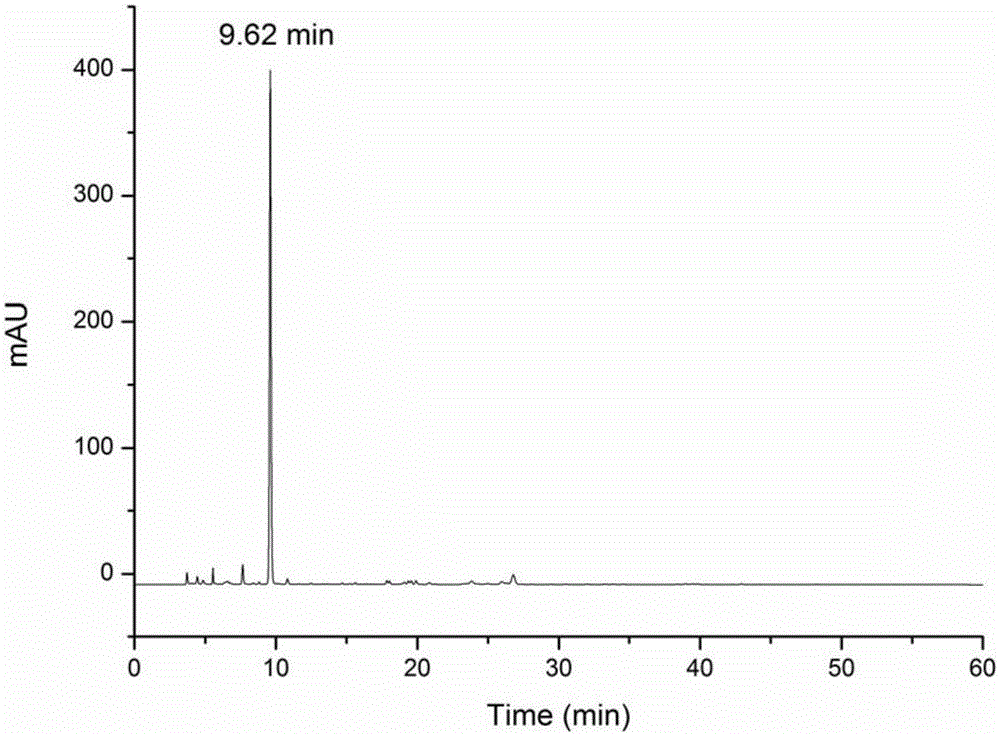Method for extracting and separating 5-O-gallic acid acyl quinine from tea dust
A technology of galloylquinic acid and 5-O-, which is applied in the field of tea extracts, can solve the problems of difficult large-scale production, high product cost, and high requirements for equipment, and achieve simple operation, high recovery rate, and high product quality. low cost effect
- Summary
- Abstract
- Description
- Claims
- Application Information
AI Technical Summary
Problems solved by technology
Method used
Image
Examples
Embodiment 1
[0023] 1. Preparation of zirconium phosphate:
[0024] 1. Take 3.58g solid ZrOCl 2 ·8H 2 After O was dissolved in 200 ml of deionized water, 7.56 g of solid (NH 4 ) 2 CO 3 , continue to stir until the solution is clear; then add 2.94g of (NH 4 ) 2 HPO 4 , and 1.01 g of cetyltrimethylammonium bromide (CTAB) was added after complete dissolution to obtain a clear reaction solution. Among them, the raw material ZrOCl 2 ·8H 2 O, (NH 4 ) 2 HPO 4 , CTAB and H 2 The molar ratio of O is ZrOCl 2 ·8H 2 O:(NH 4 ) 2 HPO 4 :CTAB:H 2 O=1:2:0.25:1000.
[0025] 2. Transfer the clarified reaction solution to a stainless steel reactor, heat it to 80°C for 2 days, 90°C for 1 day, and 120°C for 1 day; after the reaction, cool the reactor to room temperature, and centrifuge the zirconium phosphate at 5000rpm for 1 day. The solid was washed with deionized water to pH=7, dried in an oven at 80°C for 12 hours, and calcined in a muffle furnace at 550°C for 6 hours to obtain white zi...
Embodiment 2
[0041] 1. Preparation of zirconium phosphate:
[0042] The difference between the preparation method of zirconium phosphate in this example and Example 1 is: the raw material ZrOCl 2 ·8H 2 O, (NH 4 ) 2 HPO 4 , CTAB and H 2 The molar ratio of O is ZrOCl 2 ·8H 2 O:(NH 4 ) 2 HPO 4 :CTAB:H 2 O=1:2.5:0.25:1000, and the remaining operation steps and parameters are the same as those in Example 1.
[0043] 2. Preparation of 5-O-galloquinic acid:
[0044] 1. Take 1 g of Taiping Houkui tea powder that has passed through a 40-mesh sieve, add 10 mL of an ethanol solution with a volume concentration of 70%, and perform ultrasonic extraction at 50W / 45kHz for 60min; the extract is filtered through a 0.45μm membrane to obtain a crude extract.
[0045] 2. Add 0.8g of zirconium phosphate to the crude extract in the ratio of 1ml of crude extract, add the zirconium phosphate obtained in step 1 to the crude extract, under the condition of 37°C / 150rpm, shake and absorb on a shaking shak...
Embodiment 3
[0049] 1. Preparation of zirconium phosphate:
[0050] The difference between the preparation method of zirconium phosphate in this example and Example 1 is: the raw material ZrOCl 2 ·8H 2 O, (NH 4 ) 2 HPO 4 , CTAB and H 2 The molar ratio of O is ZrOCl 2 ·8H 2 O:(NH 4 ) 2 HPO 4 :CTAB:H 2 O=1:1.5:0.25:1000, and the remaining operation steps and parameters are the same as those in Example 1.
[0051] 2. Preparation of 5-O-galloquinic acid:
[0052] 1. Take 1 g of Taiping Houkui tea powder that has passed through a 40-mesh sieve, add 20 mL of ethanol solution with a volume concentration of 70%, and perform ultrasonic extraction at 75W / 45kHz for 40min; the extract is filtered through a 0.45μm membrane to obtain a crude extract.
[0053] 2. Add 0.8g of zirconium phosphate to the crude extract according to the ratio of 1ml of the crude extract. Add the zirconium phosphate obtained in step 1 to the crude extract. Under the condition of 37°C / 150rpm, vibrate and adsorb on a...
PUM
| Property | Measurement | Unit |
|---|---|---|
| recovery rate | aaaaa | aaaaa |
| purity | aaaaa | aaaaa |
| recovery rate | aaaaa | aaaaa |
Abstract
Description
Claims
Application Information
 Login to view more
Login to view more - R&D Engineer
- R&D Manager
- IP Professional
- Industry Leading Data Capabilities
- Powerful AI technology
- Patent DNA Extraction
Browse by: Latest US Patents, China's latest patents, Technical Efficacy Thesaurus, Application Domain, Technology Topic.
© 2024 PatSnap. All rights reserved.Legal|Privacy policy|Modern Slavery Act Transparency Statement|Sitemap



